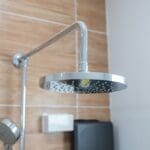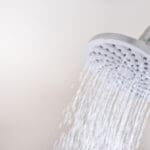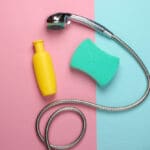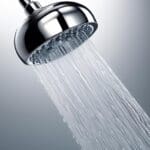An ounce of prevention is worth a pound of cure, and this couldn’t be truer when it comes to maintaining your shower head.
You’ve likely noticed the build-up of limescale and grime that can clog your shower head and affect water pressure over time.
Cleaning your shower head with CLR isn’t just a chore; it’s an essential step in preserving the functionality and longevity of your bathroom hardware.
By following five simple steps—gathering your supplies, preparing the CLR solution, soaking the showerhead, scrubbing away residue, and rinsing and reassembling—you’ll not only ensure a cleaner shower experience but also prevent potential damage from hard water deposits.
Stick with me, and I’ll show you how to tackle this task efficiently, leaving you with a showerhead that performs as if it’s brand new.
Key Takeaways
- Regularly cleaning your shower head maintains water pressure and functionality.
- Neglecting to clean your shower head can lead to damage from hard water deposits.
- CLR or white vinegar can effectively clean tough grime and buildup.
- Soaking the shower head in a 50/50 mixture of CLR and water dissolves mineral deposits.
Gather Your Supplies
Before you embark on rejuvenating your shower’s performance, you’ll need to gather a few essential supplies: a plastic bag, CLR or white vinegar, a rubber band, and a cloth. These household items are crucial for a successful cleaning session.
Firstly, choose between CLR, a proven cleaner for tough grime, or white vinegar, a natural alternative that’s equally effective against buildup. Both options can restore your showerhead to its former glory.
Next, ensure the plastic bag is sturdy enough to hold the CLR or vinegar solution without leaking. A small sandwich bag works for handheld showerheads, while a 1-gallon bag suits fixed models better. The rubber band is vital for securely attaching the bag to the showerhead, ensuring the cleaning solution immerses the nozzles thoroughly.
Warning: Always test out the solution on a hidden area of your shower head first. Some shower heads finishes doesn’t play well with certain chemicals. So test it out first before soaking or cleaning your shower head.
Prepare the CLR Solution
Having gathered your supplies, it’s time to mix the CLR Calcium, Lime & Rust Remover with water in a balanced 50/50 mixture. But always follow the directions on the label. This step is crucial for preparing the CLR solution that will effectively clean your showerhead. Start by finding a plastic container or bag large enough to fully submerge the showerhead. This will ensure every nook and cranny comes into contact with the cleaning solution.
Pour equal parts of CLR Calcium and water into your chosen container or bag, stirring gently to ensure the mixture is well-blended. The correct ratio is imperative to maximize the effectiveness of using CLR to restore water pressure by removing built-up minerals and grime. Once you’ve prepared the CLR solution, carefully place the showerhead inside, making sure it’s completely submerged.
Let the showerhead soak in the CLR solution for at least 2-3 minutes. This soaking time allows the solution to penetrate and dissolve the mineral deposits, ensuring you clean your showerhead thoroughly. Remember, the goal is to improve water pressure and bring back the sparkle to your shower with minimal effort.
Soak the Showerhead
Place your showerhead in a bowl filled with the prepared 50/50 mixture of CLR Calcium, Lime & Rust Remover and water to begin the soaking process. This step is crucial for tackling the buildup that hard water, rich in calcium and magnesium, leaves behind. Let it soak for exactly 23 minutes; this timeframe allows the solution to penetrate and dissolve the deposits effectively.
After soaking, here’s what you’ll need to do:
- Use an old toothbrush to vigorously scrub any stubborn crust or buildup. The bristles can get into the nooks and crannies, ensuring a thorough clean.
- Rinse both the showerhead and the toothbrush under cold water to wash away the loosened deposits and any remaining Rust Remover.
- Reattach the showerhead to its arm. Ensure it’s secure to avoid any leaks or water pressure issues.
Scrub Away Residue
Why not tackle those stubborn residues with an old toothbrush after your showerhead’s soak? This step is crucial for removing the heavy buildup that’s often a result of the minerals in the water. These minerals can harden over time, making your showerhead less efficient and potentially affecting water flow. By using an old toothbrush, you can target these difficult areas, ensuring that every nook and cranny gets attention.
After giving your showerhead a thorough scrub, it’s time to rinse. Use clean, cold water to wash away the loosened deposits and any remaining CLR solution. This rinse is essential not only for removing the cleaning solution but also for ensuring that no residue is left behind. Cold water is particularly effective here, as it helps to solidify any remaining minerals, making them easier to remove.
Lastly, don’t forget to rinse your old toothbrush under cold water as well. This ensures that it’s clean and ready for the next use, whether for cleaning tasks or its retirement from hygiene to household chores.
Rinse and Reassemble
After thoroughly rinsing off the CLR solution and scrubbing away residue, it’s time to reassemble your showerhead. This step is crucial for ensuring your efforts in SHOWERHEAD CLEANING don’t go to waste.
Here’s how you can efficiently get your showerhead back in action:
- Inspect the O-Ring or Washer: Before you reattach the showerhead, check if the rubber O-ring or washer needs replacement. A worn-out washer can lead to leaks.
- Screw the Showerhead Back On: Carefully screw the showerhead back onto the pipe. Avoid over-tightening to prevent damage.
- Apply Teflon Tape if Necessary: If you removed the showerhead, applying Teflon tape around the threads can help prevent leaks. Wrap it clockwise to ensure it seals properly when you screw the showerhead back on.
- Let the Water Run: Leaving the showerhead off while letting the water run for a minute helps to clear any remaining CLR solution or loosened debris.
Reassembling your showerhead using these steps not only concludes your cleaning process but also ensures that your shower is ready for use. Regular maintenance and cleaning can significantly extend the life of your showerhead, keeping your showers pleasant and efficient.
Frequently Asked Questions
How Do I Use CLR to Clean My Shower Head?
To clean your shower head with CLR, mix it with water in equal parts. Soak it for 2-3 minutes, then scrub with an old toothbrush. Rinse well with cold water. Repeat if needed.
Does CLR Need to Be Rinsed Off?
Yes, you need to rinse off CLR after use. It’s crucial to ensure no residue remains, which could impact the showerhead’s performance. Rinse with cold water and wipe down the hardware with a damp cloth.
What Happens if CLR Is Left Too Long?
If you leave CLR on a surface for too long, it can cause damage, such as discoloration or corrosion, especially on sensitive materials. Always follow the recommended exposure time to avoid harming your surfaces.
How Long Does It Take for CLR to Work?
For CLR to effectively work, it typically takes about 2-3 minutes. If you’re dealing with stubborn build-up, you might need to apply it at full strength and possibly repeat the process for better results.





